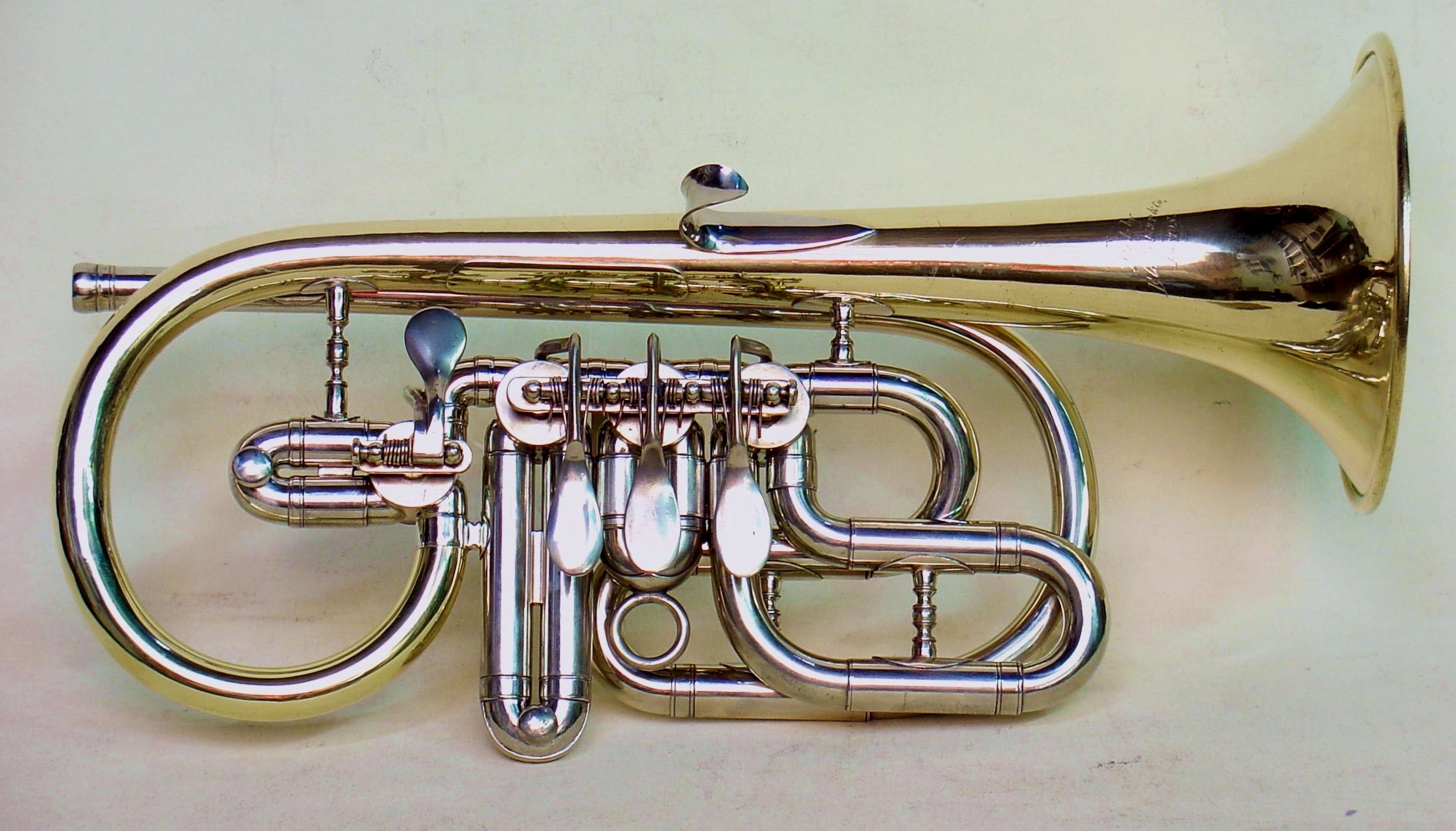Four Valve Bb Cornet by E.G. Wright
This is another important cornet from the collection of Steve Ward who shares my fascination with the Boston makers. This is a cautionary tale for those of us that wish to preserve the objects of our history. I feel strongly, that when deciding about how to treat a historical object, a determination should be made as to its importance. The more important it is, the more conservative the treatment should be, hopefully preserving as much original detail and from that, as much evidence of history, as possible.
E.G. Wright four valve Bb cornet after final restoration.
This cornet could have been judged not to be unique, since there are a number of four valve Bb cornets in this form by E.G. Wright, but this does seem to be unique in that both the material (brass bell on a nickel instrument) and design (described below) of the bell are different that other known examples. When Steve bought this, it had just been "restored", although without much sensitivity to preserving what it had been. It was shiny, but had lost some of its visual beauty and proportion. I told Steve that he could leave it as it was, looking pretty good and in playable condition, although with an additional investment, I could do my best to reverse some of the damage.
E.G. Wright four valve cornet “just restored”.
The silver plating was a good thick layer, so I first had it stripped by Anderson Silver in Elkhart. Once I took it apart, it was very clear what was original and what wasn't. The mouthpipe and tuning slide assemblies and return crook were replacements in brass rather than the original nickel silver, adapted from a piston valve cornet. It had obviously been in very rough shape before the earlier work, which had split the brass in a number of places, especially along the bell seam. In the fourth photo below it can be clearly seen that attempts were made to silver solder over the seams, hoping to avoid applying patches, Even when this sort of repair is somewhat successful, the instrument almost always needs a larger patch than was originally necessary to cover the thin and weak surface that results. I decided that there wasn't much that I could do for the most badly damaged portion of the bell curve, needing to be completely covered by patches.
Click on an image below for larger view.
Resorting to a procedure that I would normally object to, I cut that entire section off the bell and made a new piece to replace it. Fortunately, I am very familiar with Wright's cornets from the late 1860s and I was able to make new mouthpipe, crooks and tuning tubes very close to the originals. Great care was taken to mount the parts so that the cornet is visually appealing. I believe that these instrument makers took great pride in the appearance of their products.
The brass bell on a nickel silver instrument is especially attractive and I show it next to a Boston Orchestra Cornet from the 1870s made in the same materials in the last photo. You can clearly see that it has different proportions than the Boston (which was a continuation of Wright's designs). Not only is the bell shaped and curved differently to make it longer, but it has a flat oval rim that is uncharacteristic for these.
Boston Orchestra model cornet above the four valve Wright.
I was able to determine that this cornet originally had a fixed mouthpipe (without interchangeable shanks) based on the brace where it attached to the bell tube. The brace and mouthpiece receiver end of the original had been attached to the replacement mouthpipe. While never seen on those made by Boston Musical Instrument Manufactory of the same design, I have seen a few fixed mouthpipes by Wright. There is less need for a longer A shank when the cornet has the fourth valve adding a half step and it likely came with a longer tuning slide for A, as seen in this Boston as well as another Wright Bb cornet featured on this site that was made about the same time. These were both made after Wright discontinued applying the garland over the bell rim in favor of the "French rim" seen here. This change was made about 1865 or shortly after.







